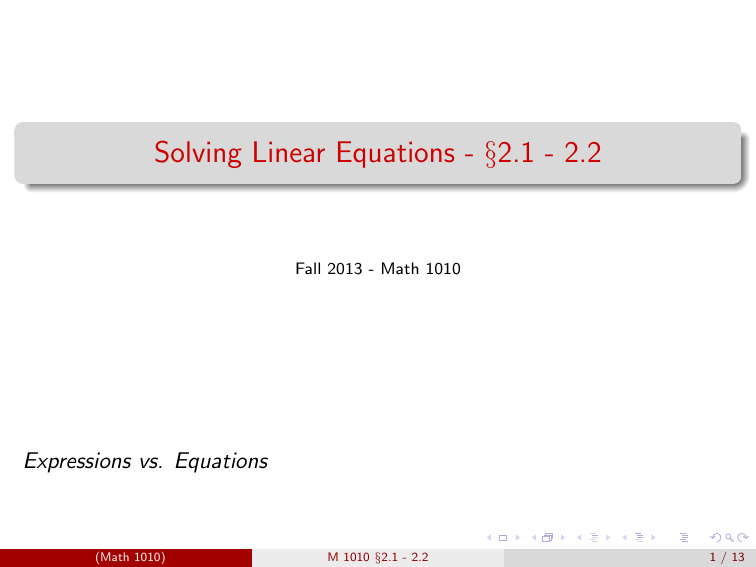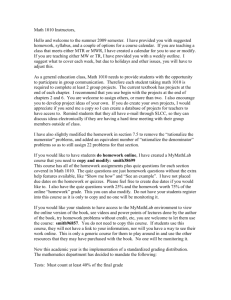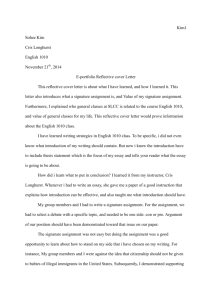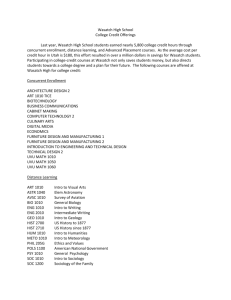Solving Linear Equations - §2.1 - 2.2 Expressions vs. Equations (Math 1010)
advertisement

Solving Linear Equations - §2.1 - 2.2 Fall 2013 - Math 1010 Expressions vs. Equations (Math 1010) M 1010 §2.1 - 2.2 1 / 13 Roadmap I Solve linear equations. I Evaluate linear equations. I Solve the real-world problems: percents, ratios, proportions. I Solve the real-world problems: business models, mixtures, rates. (Math 1010) M 1010 §2.1 - 2.2 2 / 13 §2.1 - Equations Equations are statements equating two algebraic expressions. For equations with variables, solving that equations is a search to find a value for the variable for which the equation is true. This can end in failure. (Some have no solutions.) This can end in a successful search. (Some have conditional solutions.) This can end in a hugh success. (When any, all, every real number solves the equation, it is called an identity.) (Math 1010) M 1010 §2.1 - 2.2 3 / 13 §2.1 - Seriously Seriously. Check your work by evaluating. (Math 1010) M 1010 §2.1 - 2.2 5 / 13 §2.1 - Example: Find any solutions to the equation. Then check your solution. −3x − 5 = 4x + 16 (Math 1010) M 1010 §2.1 - 2.2 6 / 13 §2.1 - Example: Find any solutions to the equation. Then check your solution. −3x − 5 = 4x + 16 Which steps in the work did you show? (Math 1010) M 1010 §2.1 - 2.2 6 / 13 §2.1 - Example: Find any solutions to the equation. Then check your solution. −3x − 5 = 4x + 16 Which steps in the work did you show? Did you check your solution? (Math 1010) M 1010 §2.1 - 2.2 6 / 13 §2.1 - Example: Find any solutions to the equation. Then check your solution. 1 2x − 4 = (6x − 3) 3 (Math 1010) M 1010 §2.1 - 2.2 7 / 13 §2.1 - Example: Find any solutions to the equation. Then check your solution. 1 2x − 4 = (6x − 3) 3 Which steps in the work did you show? (Math 1010) M 1010 §2.1 - 2.2 7 / 13 §2.1 - Example: Find any solutions to the equation. Then check your solution. 1 2x − 4 = (6x − 3) 3 Which steps in the work did you show? Did you check your answer? (Math 1010) M 1010 §2.1 - 2.2 7 / 13 §2.2 - Problem Solving The goal of §2.2 is to translate a problem into an equation and solve the equation. Often times, we already have methods to solve problems. Dispite this, using the recently discussed skills is our task. §2.2 offers problems on percents, ratios, and proportions. *Optional §2.3 offers problems in business, mixing, and the classical rate problems. I believe §2.3 is very useful, though questions like these will not be in homework, quizzes, or exams. Tip: How to use a ’rate:’ Comparing two numbers (in different measurements of units) is done with a fraction called a rate. Can any number (like 78) be a rate? Sure! Just write it as 78 1 . (Math 1010) M 1010 §2.1 - 2.2 8 / 13 §2.2 - Example Write an algebraic equation for the following problem. Follow step from §1.5 to set up a mathematical model from the verbal statements. A squirrel has stored 7 acorns. It stores 6 acorns per week. The squirrel needs 55 acorns stored. How many months will it take to reach that goal? (Math 1010) M 1010 §2.1 - 2.2 9 / 13 §2.2 - Example Write an algebraic equation for the following problem. Follow step from §1.5 to set up a mathematical model from the verbal statements. A squirrel has stored 7 acorns. It stores 6 acorns per week. The squirrel needs 55 acorns stored. How many months will it take to reach that goal? I choose four weeks per month. It follows that the monthly rate is 24 acorns each month. Verbal model: (Survival goal) = 24 × Time + (Current amount.) Labels: Survival goal = 55, Time = t, Current amount = 7. Equation: 55 = 24t + 7. (Math 1010) M 1010 §2.1 - 2.2 9 / 13 §2.2 - Percents A good model for percent problems to use: (Compared number) = (Percent in decimal form) · (Base number) (Math 1010) M 1010 §2.1 - 2.2 10 / 13 §2.2 - Percents A good model for percent problems to use: (Compared number) = (Percent in decimal form) · (Base number) Examples Each statement uses a variable for an unknown value. 1) The number 8.7 is what percent of 9.8? 2) What number is 7.2% of 128? 3) 0.112 is 81.3% of what number? (Math 1010) M 1010 §2.1 - 2.2 10 / 13 §2.2 - Ratios Percents compare one number to 100. This is one example of a ratio. Ratios can compare any two numbers. (Math 1010) M 1010 §2.1 - 2.2 11 / 13 §2.2 - Ratios Percents compare one number to 100. This is one example of a ratio. Ratios can compare any two numbers. Examples Each statement wants a ratio of two (different) measurements in the same unit. Tip: Many of these require knowledge of conversion factors. 1) Find the ratio of 30 miles per hour to 114 kilometers per hour. 2) Find the ratio of brocolli crowns priced at $1.99 per pound to brocolli priced at $1.49 per pound. 3) Which is better to buy, a 12-inch cake at $5.59, or a 14-inch cake at $6.29? (Math 1010) M 1010 §2.1 - 2.2 11 / 13 §2.2 - Proportions Percents are ratios of a number and 100, the last examples deal with general ratios. The third example in the slide on ratios compares two ratios. When two ratios are equal, they are proportional. Is the third example from the last slide a proportion? (Math 1010) M 1010 §2.1 - 2.2 12 / 13 §2.2 - Proportions Percents are ratios of a number and 100, the last examples deal with general ratios. The third example in the slide on ratios compares two ratios. When two ratios are equal, they are proportional. Is the third example from the last slide a proportion? Examples Solve each proportion. 1) A 12 oz can of soda costs 85 cents. How much will a proportional 20 oz bottle cost? 2) y −5 5 = 15 12 3) The property tax on a $45,000 valued home is $5,000. Under the same conditions what is the value of a home when taxed $8,200? (Math 1010) M 1010 §2.1 - 2.2 12 / 13 Assignment Assignment: For Wednesday: 1. Read sections 2.4, 2.5. 2. Exercises from §2.1, 2.2 due Wednesday, September 11. 3. Quiz #2 Wednesday, September 11. Vocabulary: equation, identity, condition solution, equivalence, linear equation, modelling, base numbers, percent, ratio, proportion Understand: The difference in language for problems with just expressions, and problems with just equations. Solving a linear equation. Checking a solution to an equation. Mathematically modelling real-world problems like percent, ratio, and proportion problems. (Math 1010) M 1010 §2.1 - 2.2 13 / 13




